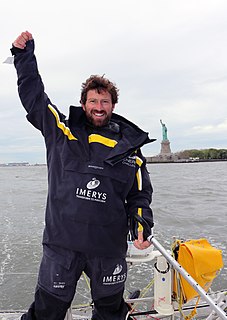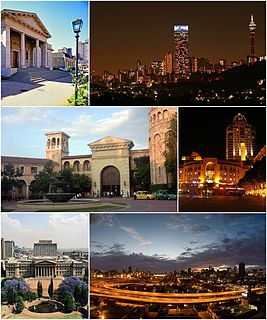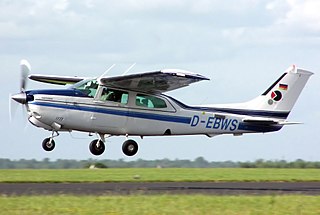
A multihull is a ship or boat with more than one hull, whereas a vessel with a single hull is a monohull.

A sailboat or sailing boat is a boat propelled partly or entirely by sails smaller than a sailing ship. Distinctions in what constitutes a sailing boat and ship vary by region and maritime culture.

Yacht racing is a form of sport involving sailing yachts and larger sailboats, as distinguished from dinghy racing. It is composed of multiple yachts, in direct competition, racing around a course marked by buoys or other fixed navigational devices or racing longer distances across open water from point-to-point. It can involve a series of races when buoy racing or multiple legs when point-to-point racing.

The Fastnet Race is a famous biennial offshore yacht race organised by the Royal Ocean Racing Club of the United Kingdom, named after the Fastnet Rock, which the race course rounds. Generally considered one of the classic offshore races, 'Fastnet' is a difficult contest testing both inshore and offshore skills, boat and crew preparation and speed potential. From its inception, the Fastnet Race has proven highly influential in the growth of offshore racing, and remains closely linked to advances in yacht design, sailing technique and safety equipment.

The IMOCA 60 is a class of advanced monohull sailing yacht administered by the International Monohull Open Class Association (IMOCA). It is dominant in single and double handed ocean racing.

Eugene Platon is an international yachtsman, participant of a number of world class sailing events, including the most prestigious Volvo Ocean Race.
The South Atlantic Race is a yacht race from Cape Town to various destinations in South America. This has been primarily Rio de Janeiro, Brazil, although Punta del Este, Uruguay, and Salvador, Brazil, have all been chosen.
The 2005 Rolex Transatlantic Challenge was celebrated at the 100th anniversary of the 1905 race for the Kaiser's Cup also known as "The Great Ocean Race". In this race, there was a skipper named Charlie Barr who raced the 3-masted schooner called Atlantic across the ocean for nearly 3,000 nautical miles (6,000 km) of the North Atlantic to set a monohull unbeaten record for the 1905 course of exactly only 12 days, 4 hours, 1 minute and 19 seconds.
Charles Barr, was an accomplished sailing skipper who three times captained winning America's Cup yachts.

Franck Cammas is a French yachtsman. He has lived in Brittany since his victory in the Challenge Espoir Crédit Agricole in 1994. After completing a two-year maths course for the ‘Grandes écoles’, as well as a piano academy, Franck Cammas finally opted for a career in sailing. In 1997, at the age of 24, he won the Solitaire du Figaro and a year later helmed his first trimaran christened Groupama. Despite his late entry into competition, he is one of the most talented and respected sailors in the Ocean Racing Multihull Association world.

Pen Duick is the name most well known for a series of ocean racing yachts sailed by French yachtsman Eric Tabarly. Meaning coal tit in Breton it was the name Tabarly's father gave to the 1898 Fife gaff cutter he purchased, and that his son learned to sail. He thereafter used the name for a series of successful racing yachts through the '60s and '70s.
John Paul Kostecki is an American competitive sailor of Polish descent. He was born in Pittsburgh, Pennsylvania. He started his sailing career in the San Francisco Bay, California.

Thomas Coville is a French yacht racer.
David Ullman is an international yachtsman, sailboat racer, and sailmaker. Ullman founded Ullman Sails in Newport Beach, California in 1967.

Stanley John Reed, more commonly known as Bertie Reed, was a South African yachtsman. He was the first South African to complete three singlehanded circumnavigations.
Keith White is a British yachtsman. In October 2015 he set out on a non-stop solo circumnavigation of the world in his yacht, the Marathon, in part to raise funds for charity. White, who is disabled, lost the use of his left arm in 1991 due to a road traffic accident. A sailor since he was 16 years old, he has achieved some significant firsts with his circumnavigation of the UK and Ireland, and his circuit of the Atlantic.
The following outline is provided as an overview of and topical guide to sailing:

Phil Sharp is a British yachtsman, born in Jersey, educated at Victoria College Jersey and qualified from Imperial College London with an MSc in Mechanical Engineering. Sharp holds World Speed Sailing Records. and Guinness World Records for the Cowes to Dinard monohull under 60 ft singlehanded, and crewed around Britain and Ireland under 40 ft.

















